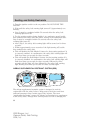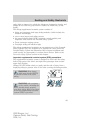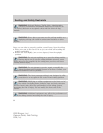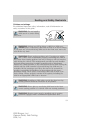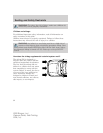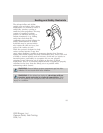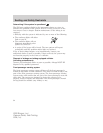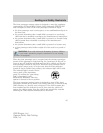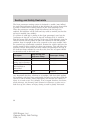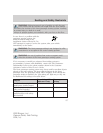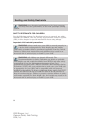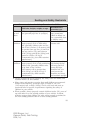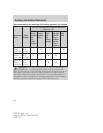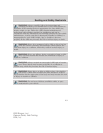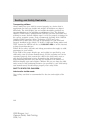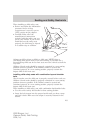
The front passenger sensing system is designed to enable (may inflate)
the right front passenger’s frontal air bag anytime the system senses that
a person of adult size is sitting properly in the front passenger seat.
When the passenger sensing system has allowed the air bag to be
enabled, the indicator will be unlit and stay unlit to remind you that the
air bag is enabled (may inflate).
If a person of adult-size is sitting in the front passenger’s seat, but the
Љpassenger air bag offЉ or Љpass air bag offЉ indicator is lit, it could be
that the person isn’t sitting properly in the seat. If this happens, turn the
vehicle off and ask the person to place the seatback in the full upright
position, then sit upright in the seat, centered on the seat cushion, with
the person’s legs comfortably extended. Restart the vehicle and have the
person remain in this position for about two minutes. This will allow the
system to detect that person and then enable the passenger’s air bag. If
the indicator lamp remains lit even after this, then the occupant should
be advised to ride in the back seat.
Occupant
Pass Airbag Off
Indicator Lamp
Passenger Airbag
Empty seat Unlit Disabled
Small child in child
safety seat or booster
Lit Disabled
Small child with safety
belt buckled or
unbuckled
Lit Disabled
Adult Unlit Enabled
After all occupants have adjusted their seats and put on safety belts, it’s
very important that they continue to sit upright, with their back against
the seatback, with their feet comfortably extended on the floor while the
vehicle is still in motion. Sitting improperly can increase the chance of
injury in a crash event. For example, if an occupant slouches, lies down,
turns sideways, sits forward, leans forward or sideways, or puts one or
both feet up, the chance of injury during a crash is greatly increased.
2009 Ranger (ran)
Owners Guide, 2nd Printing
USA (fus)
Seating and Safety Restraints
96



